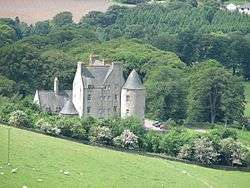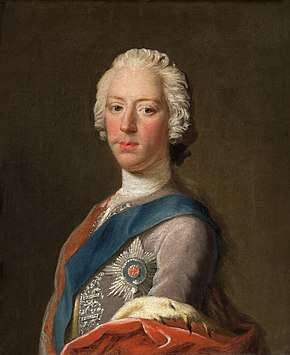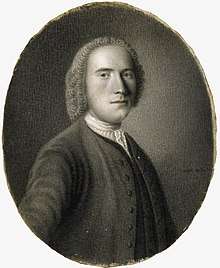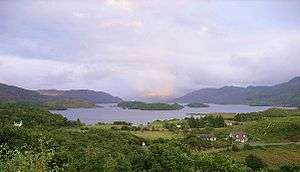John Murray of Broughton
Sir John Murray of Broughton, 7th Baron Stanhope (c. 1715 – 6 December 1777), also known as Murray of Broughton served as Jacobite Secretary of State in charge of civilian administration during the 1745 Rising.
Sir John Murray of Broughton, 7th Baron Stanhope | |
|---|---|
 Modern Broughton Place; built on site of Murray's birthplace in 1935, based on the original 17th century design | |
| Tenure | 1770-1777 |
| Predecessor | Sir David Murray (died 1770) |
| Successor | Sir David Murray (died 1791) |
| Other names | Secretary Murray Mr Evidence Murray |
| Born | 10 October 1715 Broughton, Peebleshire |
| Died | 6 December 1777 (aged 62) Cheshunt, Hertfordshire |
| Buried | East Finchley Cemetery, London |
| Nationality | Scottish |
| Wars and battles | 1745 Rising |
| Offices | Jacobite Secretary of State 1745 to 1746 |
| Spouse(s) | (1) Margaret Ferguson (2) Miss Webb |
| Issue
Numerous; including David (1743-1791), Robert (1745-1793), Lt-General Thomas Murray (ca 1749-1816) Charles Murray (1754-1821) | |
| Parents | Sir David Murray (ca 1652-1729) Margaret Scott |
Captured in June 1746 after the Battle of Culloden, he was taken to London and later provided testimony against a number of those tried for pro-Jacobite activities, including Lord Lovat. His motives are still disputed but one factor appears to have been bitterness towards those who failed to deliver support promised in advance of the Rising.
Released in 1748, he retired into a life of relative obscurity until his death in 1777. Although denounced as a traitor by some of his former colleagues, he retained his Jacobite beliefs and was one of the few to remain on good terms with Prince Charles.
Life

John Murray was born in Broughton in the Scottish Borders, younger son of Sir David Murray and his second wife Margaret Scott. His father took part in the 1715 Rising but was pardoned and thereafter focused on restoring the family fortunes. In 1726, he sold his estates in Broughton, investing the proceeds in purchasing lands in Ardnamurchan and lead mines at Strontian.[1]
In 1739, Murray married Margaret, daughter of Colonel Robert Ferguson of Nithsdale. The Fergusons were a well-known Covenanter family and Robert served with the Cameronians, a regiment originally recruited from militant Presbyterians in 1689.[2] They had five children, including three sons, David (1743-1791), Robert (1745-1793) and Lt-General Thomas Murray (ca 1749-1816).
Margaret was reportedly one of the beauties of her time and they divorced sometime before 1749, after accusations of adultery on both sides. Murray's second wife was 'a young Quaker lady named Webb, whom he found in a provincial boarding-school in England.'[3] This marriage produced six children, the most noteworthy being actor and dramatist Charles Murray (1754-1821).
His nephew Sir David, fourth baron Stanhope, also took part in the 1745 Rising and lost both lands and title; pardoned on condition he went into exile, he died in Livorno in 1752. The title of Baron Stanhope was restored in the 1760s and eventually passed to Murray in 1770, then to his eldest son David in 1777.
Career

Murray attended the University of Edinburgh from 1732 to 1735, before enrolling at the University of Leyden in the Dutch Republic. In 1737, he embarked on the 18th century cultural excursion known as the Grand Tour; this included Rome, one of whose attractions was seeing the exiled James Stuart and his sons.[4] The Jacobite cause had been largely dormant since the 1719 Rising and when Murray met him, James was living quietly in Rome "having abandoned all hope of a restoration."[5]
Meeting the Stuarts was enough for most but in August, Murray was admitted to the Masonic lodge in Rome, whose members included James Edgar, private secretary to James. The Lodge was later described by historian Andrew Lang as 'a nest of Jacobites' and this seems to be the origin of Murray's career as a Jacobite activist.[6]
Jacobite activist
After returning to Scotland in December 1738, Murray married Margaret Ferguson and repurchased the family estate of Broughton, later sold in 1764 to James Dickson, a wealthy merchant and Member of Parliament.[7] In 1741, the Duke of Hamilton approved his appointment as principal Jacobite agent in Scotland following the death of Colonel James Urquhart.[8]
The outbreak of the War of the Austrian Succession in 1740 placed Britain and France on opposing sides and Murray made frequent visits to Paris, carrying messages between Scottish Jacobites and Lord Sempil, the Stuart agent in Paris. Defeat at Dettingen in June 1743 prompted Louis XV to look for ways to divert British resources, including a proposed invasion of England in early 1744 to restore the Stuarts. Charles secretly joined the invasion force in Dunkirk but the attempt was cancelled in March after the French fleet was severely damaged by winter storms.[9]
In August, Charles travelled to Paris to argue for an alternative landing in Scotland, where he met with Murray, telling him he was "determined to come to Scotland, though with a single footman".[10] After his return to Edinburgh in December, Murray shared this news with the pro-Jacobite Buck Club, whose members included James, later 6th Duke of Hamilton and Lord Elcho. They prepared a written declaration urging him not to do so, unless he brought 6,000 French troops, money and weapons; this was given to the 5th Earl of Traquair (1699-1764) for delivery but was never sent.[11]
Secretary Murray; the 1745 Rising

In late June, Murray learned Charles was preparing to sail from France and waited in Western Scotland for three weeks, hoping to dissuade him from landing. He eventually gave up and was at home when news came of their arrival at Eriskay on 23 July.[12] After Charles refused to return to France, Murray became Secretary, with responsibility for civilian administration and finances. One way to rise money was to collect existing taxes and many towns paid twice, as the government refused to recognise payments to the Jacobites; in 1753, Paisley unsuccessfully sued Murray for £500 levied in 1745.[13]
The Jacobite army marched on Edinburgh, reaching Perth on 3 September; here they were joined by Lord George Murray, who had participated in the 1715 and 1719 Risings. Pardoned in 1725, he had settled down to life as a Scottish country gentleman; his brother Tullibardine accompanied Charles to Scotland but his eldest son was a British army officer. His defection surprised both sides and many Jacobites viewed him with suspicion, not helped by his poorly concealed view of Charles as a 'reckless adventurer.'[14] Murray was later blamed for the frequent clashes between Charles and his senior Scottish commander, but even admirers recorded Lord George's talents were offset by a quick temper, arrogance and inability to take advice.[15]

Murray accompanied the army into England and helped negotiate the surrender of Carlisle in November.[16] He was not part of the Prince's War Council and thus avoided responsibility for the decision to retreat at Derby; this marked a major deterioration in the relationship between Charles and the Scots, Murray being one of the few to retain his trust.[17] After the unsuccessful siege of Stirling was abandoned in early February, the Jacobites retreated to Inverness; in March, Murray fell ill and was replaced by the far less capable Hay of Restalrig.[18]
Money and basic items like shoes were now so short soldiers were paid in oatmeal and supplies requisitioned from local shopkeepers.[19] When the campaign reopened in April, the leadership decided only a decisive victory could change the strategic position; defeated at the Battle of Culloden, Charles ordered his remaining troops to disperse until he returned from France with additional support.[20]
In early May, two French privateers arrived in Loch nan Uamh, bringing 35,000 gold coins packed in seven barrels for the Jacobite war effort. With the Royal Navy close behind, the money was hastily landed and the French ships fought their way out, carrying a number of senior officers, including Lord John Drummond and the Duke of Perth.[21] Murray was in Leith seeking passage to Holland with Lochiel and his younger brother Archibald Cameron when they heard of the ships arrival. Hoping to use these funds to continue the war, the three travelled to Loch nan Uamh and took charge of the money, although one barrel was missing.[22]
What happened to the rest is unclear; Murray claimed some was distributed in back pay and the bulk consigned to Archibald Cameron for safekeeping, which agrees with the detailed account provided by Cameron in 1750.[23] In the recriminations that followed defeat, various people were accused of stealing it, including Cameron, executed in 1753 after returning to Scotland allegedly to dig it up, Alastair MacDonnell, aka Pickle the spy, who spent the Rising in the Tower of London and MacPherson of Cluny. Despite suggestions it remains hidden, modern-day treasure hunters have yet to find any trace of it.[24]

A few days later, Lochiel, Murray, Glenbucket, John Roy Stewart and others met near Loch Morar to discuss options. They were joined by Lord Lovat, who had avoided personal participation but supplied the Jacobites with 300 Frasers under his son, Simon, Master of Lovat. All agreed to continue a guerrilla campaign and reassemble a few days later with their men, using the French money to cover arrears of pay. Lovat asked that his share be given directly to his 'steward', which Murray implies was a ruse to obtain part of the money for himself. When they reassembled a few days later, those who did show up brought substantially fewer men than agreed, while many did not attend at all, including the Frasers.[25]
Plans to continue the fight were abandoned and with government forces searching for them, the group split up. Still hoping to arrange passage from Leith and suffering from severe dysentery, Murray made his way to his sister's house at Polmood. He was arrested there on 27 June, although it was later suggested that he sent messages asking to be taken into custody. He was transferred to the Tower of London in early July, along with other senior Jacobites, including Lovat, who had been apprehended in early June.[26] Lochiel, Archibald Cameron, Glenbucket and others finally met up with Prince Charles and were picked up by a French ship in September.[27]
Trial and later life

Murray was provided with a French officer's commission in 1743, in the hope this would allow him to be treated as a prisoner of war, rather than a rebel but this was rejected. The same defence failed to save Francis Towneley, commander of the Manchester Regiment; he was executed on 30 July despite being a major with eight years service in the French army.[28]
Most high-ranking Jacobite prisoners were tried and sentenced before Murray arrived in London but he agreed to provide information against his former associates in return for a pardon. While some accounts claim Murray's testimony led to Lovat's execution, it was primarily used to confirm details of the evidence; Lovat's participation was not in dispute and many contemporaries felt he would have been executed anyway. In October 1745, Lovat had attempted to kidnap his long-term associate Duncan Forbes, chief legal officer in Scotland, who wrote that his motive was to 'ruin and subvert the government, because they (would not) gratify his...avaricious passions and desires.'[29]
Of far greater long-term significance was Murray's testimony against sympathisers who failed to support the Rising, although he avoided incriminating those he had not met, like the Duke of Beaufort, known to be 'a most determined and unwavering Jacobite.'[30] As with Lovat, he largely confirmed details already known, such as the meeting between Charles and Sir John Douglas, MP for Dumfriesshire at Stirling in January 1746.[31] Two of his brothers served in the Jacobite army so Douglas' sympathies were hardly unknown but Murray stated he was surprised to see him, 'never having suspected him to be in the Pretender's interest.'[32]
No further action was taken against Douglas and others but this ended the practice whereby many British politicians could in theory support the overthrow of their own government and institutions with impunity.[33] The Tory Jacobite leader Williams-Wynn shows why the government considered this necessary; on various occasions prior to 1745, he provided Stuart agents with promises of support but spent the Rising in London. Despite this, he wrote to Charles in late 1747 claiming his supporters wished for 'another happy opportunity wherein they may exert themselves more in deeds than in words, in the support of your Royal Highness's dignity and interest and the cause of liberty.'[34]
Released from the Tower after Lovat's execution, Murray was formally pardoned in June 1748 and disappeared into obscurity. He purchased a property in Cheshunt, outside London, where he was reportedly visited by Charles in 1763, remarried and had another six children. He was allegedly treated for alcoholism on a number of occasions; he succeeded his nephew David as Baron Stanhope in 1770 and died at home in December 1777.
Assessment

Assessing Murray is complicated because arguments over responsibility for the failure of the Rising often reflected deep divisions within the Jacobite camp. In their accounts, Maxwell of Kirkconnel and Lord Elcho both accused him of deliberately poisoning relations between Charles and Lord George Murray but Maxwell in particular detested Murray and cannot be viewed as an impartial witness.[35]
In the notes to their 1930 edition of Lord Pitsligo's Letters, the Taylers claim Murray was strongly in favour of the...expedition to Scotland, and made the utmost of all the promises of support, which he poured into the ready ear of Charles....[36] While hard to determine the exact truth, the available evidence shows Charles decided to make the attempt before he even met Murray and despite being strongly urged not to do so by nearly everyone he contacted.[37]
Those who accused him of 'treachery' included people like Sir Watkin Williams-Wynn who failed to follow through on promises of support; Murray later wrote 'virtue [may be] admird and Esteemed even by those who have not the fortitude to pursue it.'[38] Most anecdotes about him come from Tales of a Grandfather, a history of Scotland written for his grandson in 1828 by novelist Sir Walter Scott; while its timeline of events is broadly accurate, many of the stories cannot be verified.[39] They include the claim that when asked if he knew Murray, Douglas responded 'once I knew...a Murray of Broughton, but that was a gentleman and a man of honour.'[40] Another concerns Scott's father, who allegedly acted as Murray's lawyer; according to Scott, his mother once took them tea and after Murray left, his father threw the cup out of the window, exclaiming "I may admit into my house...persons wholly unworthy to be treated as guests... Neither lip of me nor of mine comes after Mr. Murray of Broughton's."[41]
References
- Murray, John (1898). Bell, Robert Fitzroy (ed.). Memorials of John Murray of Broughton: Sometime Secretary to Prince Charles Edward, 1740-1747. T. and A. Constable at the Edinburgh University Press for the Scottish History Society. p. 24. OCLC 879747289.
- "Fergusson of Caitloch". Ferguson DNA Project. Retrieved 6 May 2019.
- Henderson, Thomas Finlayson (1894). Sir John Murray of Broughton in Dictionary of National Biography, 1885-1900, Volume 39. Smith & Elder.
- Riding, Jacqueline (2016). Jacobites: A New History of the 45 Rebellion. Bloomsbury. pp. 10–11. ISBN 978-1408819128.
- Blaikie, Walter Biggar (1916). Origins of the 'Forty-Five, and Other Papers Relating to That Rising. T. and A. Constable at the Edinburgh University Press for the Scottish History Society. p. xlix. OCLC 2974999.
- Lang, Andrew (1907). The History Of Scotland – Volume 4: From the massacre of Glencoe to the end of Jacobitism (2016 ed.). Jazzybee Verlag. p. 314. ISBN 978-3849685652.
- Namier, Lewis, Brooke, John (1964). The House of Commons 1754-1790 (1985 ed.). Haynes Publishing. p. 322. ISBN 978-0436304200.
- Way, George (1994). The Collins Scottish Clan Encyclopedia. Collins. pp. 336–337. ISBN 978-0004705477.
- Harding, Richard (2013). The Emergence of Britain's Global Naval Supremacy: The War of 1739–1748. Boydell Press. p. 171. ISBN 978-1843838234.
- Murray, p. 93
- Lord Elcho (author), Charteris, Evan (ed) (1907). A Short Account of the Affairs of Scotland. David Douglas, Edinburgh. pp. 62–63.CS1 maint: extra text: authors list (link)
- Kybert, Susan Maclean "Bonnie Prince Charlie: A biography" p122-3
- Rowands, David. "Paisley in a panic". Paisley. Retrieved 7 May 2019.
- McLynn, FJ (1983). The Jacobite Army in England, 1745-46: The Final Campaign. John Donald Publishers. p. 46. ISBN 978-0859760935.
- Riding, pp. 124–125
- Kybert, Susan Maclean "Bonnie Prince Charlie: A biography" p168
- Riding, pp. 304-305
- Nicolson, Eirwen, E.C (2006). Murray, Sir John, of Broughton, baronet (Online ed.). Oxford DNB. doi:10.1093/ref:odnb/19629.
- Annand, A Mck (1994). "Lord Kilmarnock's Horse Grenadiers (Later Foot Guards), in the Army of Prince Charles Edward, 1745-6". Journal of the Society for Army Historical Research. 72 (290): 72.
- Stuart, Charles Edward (28 April 1746), Letter from Prince Charles Edward Stuart to the Scottish Chiefs, justifying his reasons for leaving Scotland after the Battle of Culloden (letter), RA SP/MAIN/273/117CS1 maint: ref=harv (link)
- Murray, p. 388
- Zimmerman, Doron (2003). The Jacobite Movement in Scotland and in Exile, 1746-1759. AIAA. p. 27. ISBN 978-1403912916.
- "Dr. Archibald Cameron's Memorial Concerning the Locharkaig Treasure (Stuart Papers, Vol. 300, No. 80) circa 1750". Clan Cameron. Retrieved 6 May 2019.
- Cowie, Ashley. "Jacobite Gold". Ashley Cowie. Retrieved 6 May 2019.
- Murray, p. 93
- Riding, p. 462
- Riding, p. 493
- Riding, p. 474
- Riding, p. 496
- Walpole, Horace (1833). Letters to Sir Horace Mann. 28027933: G Dearborn. pp. 29th March 1745.CS1 maint: location (link)
- Murray, p. 436
- Murray, p. 437
- Zimmerman, p. 202
- Forbes, John. The History of Parliament: the House of Commons 1715-1754. Parliament Online. Retrieved 11 April 2019.
- Nicolson, Oxford DNB
- Tayler, Alistair (ed), Tayler, Henrietta (ed) (1930). Jacobite Letters to Lord Pitsligo 1745-1746. Milne & Hutchison. p. 12.CS1 maint: extra text: authors list (link)
- Stephens, Jeffrey (2010). "Scottish Nationalism and Stuart Unionism: The Edinburgh Council, 1745". Journal of British Studies. 49 (1): 51. JSTOR 27752690.
- Murray, p. 252
- Shaw, Frank. "Review of 'Scotland; Story of a Nation'". Electrics Scotland. Retrieved 23 April 2019.
- Lockhart, John Gibson (1842). Memoirs of the Life of Sir Walter Scott (2016 ed.). Palala Press. p. 49. ISBN 978-1357265618.
- Hutton, Richard M. (1888) Sir Walter Scott. London. MacMillan and Co.
Sources
- Annand, A Mck (1994). "Lord Kilmarnock's Horse Grenadiers (Later Foot Guards), in the Army of Prince Charles Edward, 1745-6". Journal of the Society for Army Historical Research. 72 (290).
- Blaikie, Walter Biggar (1916). Origins of the 'Forty-Five, and Other Papers Relating to That Rising. T. and A. Constable at the Edinburgh University Press for the Scottish History Society. OCLC 2974999.
- Lord Elcho (author), Charteris, Evan (ed) (1907). A Short Account of the Affairs of Scotland. David Douglas, Edinburgh.CS1 maint: extra text: authors list (link)
- Forbes, John. The History of Parliament: the House of Commons 1715-1754.
- Henderson, Thomas Finlayson (1894). Sir John Murray of Broughton in Dictionary of National Biography, 1885-1900, Volume 39. Smith & Elder.
- Kybert, Susan Maclean (1988) Bonnie Prince Charlie: A biography. Unwin. ISBN 0-04-440387-9
- Lang, Andrew (1907). The History Of Scotland – Volume 4: From the massacre of Glencoe to the end of Jacobitism (2016 ed.). Jazzybee Verlag. ISBN 978-3849685652.
- Lockhart, John Gibson (1842). Memoirs of the Life of Sir Walter Scott. Palala Press. ISBN 978-1357265618.
- McLynn, FJ (1983). The Jacobite Army in England, 1745-46: The Final Campaign. John Donald Publishers. ISBN 978-0859760935.
- Murray, John (1898). Bell, Robert Fitzroy (ed.). Memorials of John Murray of Broughton: Sometime Secretary to Prince Charles Edward, 1740-1747. T. and A. Constable at the Edinburgh University Press for the Scottish History Society. OCLC 879747289.
- Namier, Lewis, Brooke, John (1964). The House of Commons 1754-1790. Haynes Publishing. ISBN 978-0436304200.
- Stephens, Jeffrey (2010). "Scottish Nationalism and Stuart Unionism: The Edinburgh Council, 1745". Journal of British Studies. 49 (1).
- Way, George (1994). The Collins Scottish Clan Encyclopedia. Collins. ISBN 978-0004705477.
- Zimmerman, Doron (2003). The Jacobite Movement in Scotland and in Exile, 1746-1759. AIAA. ISBN 978-1403912916.
External links
- Cowie, Ashley. "Jacobite Gold". Ashley Cowie. Retrieved 6 May 2019.
- Rowands, David. "Paisley in a panic". Paisley. Retrieved 7 May 2019.
- Shaw, Frank. "Review of 'Scotland; Story of a Nation'". Electrics Scotland. Retrieved 23 April 2019.
| Peerage of Scotland | ||
|---|---|---|
| Preceded by Sir David Murray (nephew) |
Baron Stanhope 1770–1777 |
Succeeded by Sir David Murray (son) |